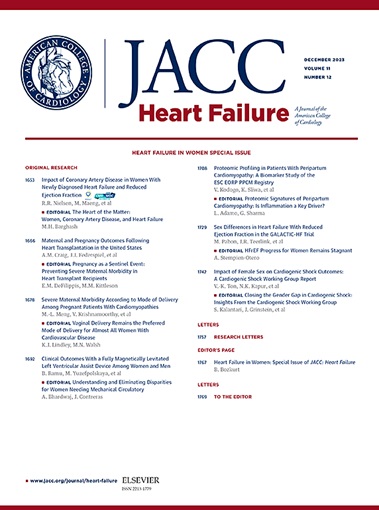Sex Differences in Efficacy of Multidomain Rehabilitation Among Older Adults With Acute HF
IF 11.8
1区 医学
Q1 CARDIAC & CARDIOVASCULAR SYSTEMS
引用次数: 0
Abstract
Background
A multidomain physical rehabilitation intervention (REHAB-HF [Rehabilitation Therapy in Older Acute Heart Failure Patients] intervention) has been associated with significant improvements in physical function and quality of life (QOL) among older patients with acute decompensated heart failure (ADHF).
Objectives
This study aims to evaluate sex differences in the treatment effect of a multidomain rehabilitation intervention among participants of the REHAB-HF trial.
Methods
In this prespecified secondary analysis of the REHAB-HF trial, sex differences in the treatment effect of the REHAB-HF intervention (vs attention control) on key 3-month outcomes of the Short Physical Performance Battery (SPPB, primary), frailty burden, 6-minute walking distance (6MWD), and QOL were assessed. Statistical significance for treatment effect interaction (sex∗intervention) was set at 0.1.
Results
Among the 349 trial participants, female patients (n = 183) had a significantly lower baseline SPPB score and 6MWD and a higher frailty burden than male patients (n = 166). Female (vs male) participants had a significantly greater improvement in SPPB (effect size: 1.9 [95% CI: 1.1-2.7] vs 1.0 [95% CI: 0.1-1.8]; P for interaction = 0.1) and frailty burden, as assessed by Fried phenotype criteria (effect size: −0.5 [95% CI: −0.9 to −0.2] vs 0.00 [95% CI: −0.4 to 0.4]; P for interaction = 0.04) with the REHAB-HF intervention. The magnitude of the improvement in 6MWD and QOL (Kansas City Cardiomyopathy Questionnaire score) with the REHAB-HF intervention was also greater among female (vs male) participants without a significant treatment effect interaction by sex. There was no significant difference in rates of adverse clinical outcomes associated with the intervention across both sex groups. There was no difference in intervention adherence by sex.
Conclusions
Female (vs male) participants with ADHF had a significantly greater improvement in physical function in response to the REHAB-HF intervention.
老年急性心衰患者多领域康复疗效的性别差异:REHAB-HF试验。
背景:一项多领域的物理康复干预(REHAB-HF [rehabilitation Therapy in老年急性心力衰竭患者]干预)与老年急性失代偿性心力衰竭(ADHF)患者的身体功能和生活质量(QOL)的显著改善有关。目的:本研究旨在评估多领域康复干预在REHAB-HF试验参与者中治疗效果的性别差异。方法:在这项预先设定的REHAB-HF试验的二次分析中,评估了REHAB-HF干预(与注意控制)对短体能测试(SPPB,初级)、虚弱负担、6分钟步行距离(6MWD)和生活质量关键3个月结局的治疗效果的性别差异。治疗效果相互作用(性别*干预)的统计显著性设为0.1。结果:在349名试验参与者中,女性患者(n = 183)的基线SPPB评分和6MWD明显低于男性患者(n = 166),且虚弱负担更高。女性(相对于男性)受试者在SPPB(效应值:1.9 [95% CI: 1.1-2.7] vs 1.0 [95% CI: 0.1-1.8];交互作用的P值= 0.1)和虚弱负担方面有显著更大的改善,通过Fried表型标准评估(效应值:-0.5 [95% CI: -0.9至-0.2]vs 0.00 [95% CI: -0.4至0.4];交互作用的P值= 0.04)。在不存在显著治疗效果的性别差异的情况下,接受康复-心力衰竭干预的女性参与者(与男性相比)在6MWD和QOL(堪萨斯城心肌病问卷评分)方面的改善程度也更大。与干预相关的不良临床结果发生率在两性别组之间没有显著差异。干预依从性没有性别差异。结论:女性(与男性)ADHF参与者在康复- hf干预后的身体功能改善显著大于男性。
本文章由计算机程序翻译,如有差异,请以英文原文为准。
求助全文
约1分钟内获得全文
求助全文
来源期刊

JACC. Heart failure
CARDIAC & CARDIOVASCULAR SYSTEMS-
CiteScore
21.20
自引率
2.30%
发文量
164
期刊介绍:
JACC: Heart Failure publishes crucial findings on the pathophysiology, diagnosis, treatment, and care of heart failure patients. The goal is to enhance understanding through timely scientific communication on disease, clinical trials, outcomes, and therapeutic advances. The Journal fosters interdisciplinary connections with neuroscience, pulmonary medicine, nephrology, electrophysiology, and surgery related to heart failure. It also covers articles on pharmacogenetics, biomarkers, and metabolomics.
 求助内容:
求助内容: 应助结果提醒方式:
应助结果提醒方式:


